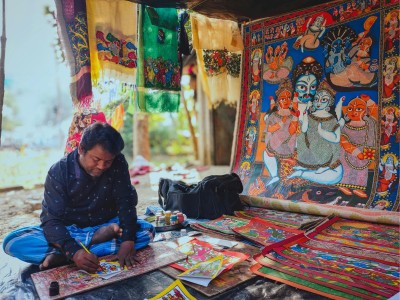Global Inspirations: The Cross-Cultural Exchange of Art
-1745569776.jpg)
Art, in its many forms, has always transcended borders, creating connections between distant cultures and societies. From ancient times to the present day, the exchange of artistic ideas, styles, and techniques has played a significant role in shaping the art world and broadening cultural understanding. The concept of cross-cultural exchange is rooted in the belief that art is a universal language that can speak to the heart and mind, no matter where it originates. Through trade, exploration, migration, and diplomacy, art has traveled across the globe, influencing and being influenced by diverse cultures along the way.
This exchange has enriched artistic traditions, inspired new forms of expression, and contributed to the creation of a shared global culture that we can appreciate and learn from today.
1. Early Cross-Cultural Exchange: The Silk Road and Beyond
The Silk Road, a vast network of trade routes connecting the East and the West, is one of the most prominent examples of cross-cultural exchange in ancient times. While it was primarily a conduit for the exchange of goods—silk, spices, and precious metals—it also facilitated the sharing of ideas, religions, and, of course, art. As merchants, travelers, and conquerors moved across continents, they carried with them artistic techniques and aesthetic preferences that merged with those of other regions.
The Influence of Chinese Art on Central Asia and Europe
One of the earliest examples of cross-cultural artistic exchange occurred along the Silk Road between China, Central Asia, and Europe. Chinese silk weaving techniques, for instance, found their way into the fabric designs of Central Asian nomadic tribes, while Persian artists adopted Chinese painting techniques, particularly the use of fine brushstrokes and delicate detailing. This melding of artistic traditions eventually influenced the artistic styles of the Byzantine Empire and the Renaissance in Europe.
In return, Chinese artists were exposed to influences from India, Persia, and Greece. Buddhist art, which spread from India to China along the Silk Road, is a prime example of this. The iconic Buddha statues that are so central to East Asian Buddhist art were inspired by Greco-Roman artistic styles. These statues were eventually adapted by Chinese artists, resulting in a distinctive form of Buddhist art that blends Indian spiritual themes with Greco-Roman aesthetic elements.
2. The Renaissance and the Revival of Classical Art
The Renaissance, which spanned from the 14th to the 17th century, is another pivotal moment in the history of cross-cultural artistic exchange. During this period, Europe experienced a renewed interest in the classical art and philosophy of ancient Greece and Rome. However, the Renaissance artists were not merely revisiting the works of the past; they were also absorbing influences from the Islamic world, Africa, and Asia.
Islamic Influence on European Renaissance Art
While Europe was experiencing its own artistic revival, the Islamic world was also flourishing, particularly in the fields of architecture, calligraphy, and ceramics. The intricate geometric patterns and floral designs characteristic of Islamic art found their way into Renaissance artwork, as Italian artists such as Raphael and Leonardo da Vinci were exposed to Islamic decorative elements through trade and interaction with Islamic Spain and the Ottoman Empire. These influences were especially evident in the use of intricate patterns and the development of new color palettes.
Moreover, the introduction of Persian miniature paintings and the influence of Ottoman art had a lasting impact on European decorative arts. The use of vivid colors, exotic themes, and elaborate designs became prominent in European furniture, textiles, and ceramics.
3. Colonialism and the Fusion of Artistic Traditions
The Age of Exploration and the colonial period from the 15th to the 19th century marked a new chapter in the cross-cultural exchange of art. As European powers established colonies in the Americas, Africa, and Asia, they brought with them their own artistic traditions and introduced these to the indigenous peoples of the regions they colonized. However, the interaction was not one-sided. The exchange between colonizers and colonized peoples led to the fusion of artistic traditions, creating hybrid forms of art that reflected the complex and often tumultuous relationships between cultures.
African Art’s Influence on Western Modernism
Perhaps one of the most striking examples of this cross-cultural fusion is the influence of African art on Western modernism. In the late 19th and early 20th centuries, European artists like Pablo Picasso and Henri Matisse were exposed to African masks and sculptures, which they encountered through exhibitions and collections of African art brought back to Europe. The bold, geometric shapes and abstract forms in African art inspired Picasso's groundbreaking work in Cubism, and Matisse's exploration of vibrant color and fluid shapes was influenced by African visual aesthetics.
African art’s impact on European modernism is a testament to the power of cross-cultural exchange, as it introduced a new visual language to Western art that emphasized abstraction, simplification, and a deeper connection to the human spirit. These innovations led to a profound shift in the direction of Western art in the 20th century.
4. Globalization and Contemporary Art
In today’s globalized world, the cross-cultural exchange of art is more widespread than ever. Thanks to the internet, social media, and international art fairs, artists from all corners of the globe are able to share their work, ideas, and techniques with a global audience. This has led to the emergence of new hybrid art forms that blend traditional practices with contemporary influences.
Fusion of Global Styles
Contemporary artists are increasingly drawing inspiration from diverse cultures, creating art that reflects the interconnectedness of the modern world. For instance, the global influence of street art has resulted in a merging of Western graffiti culture with traditional art forms from Africa, Asia, and Latin America. Artists such as Jean-Michel Basquiat and Banksy have drawn from a variety of cultural references, blending graffiti with elements of fine art, political commentary, and popular culture.
Another example is the increasing popularity of digital art, where artists from around the world collaborate across borders to create virtual works that are displayed online. This form of art allows for a new kind of cultural exchange, as artists can interact with one another in real-time, share ideas, and create collaborative works that would have been impossible just a few decades ago.
5. Art as a Tool for Cultural Diplomacy
In addition to its artistic value, cross-cultural exchange also serves as a form of cultural diplomacy. Through art exhibitions, international collaborations, and global art festivals, art serves as a bridge between different nations and cultures. These exchanges foster mutual understanding and respect, promoting dialogue and creating a space for the sharing of ideas, values, and traditions.
The Venice Biennale, for example, is a prestigious international art exhibition that brings together artists from around the world, offering them a platform to showcase their work and engage with global audiences. Similarly, art festivals in places like Dakar, São Paulo, and Sharjah have become important cultural hubs, facilitating cross-cultural exchange and highlighting the contributions of artists from underrepresented regions.
A Global Tapestry of Artistic Influence
The cross-cultural exchange of art has been a powerful force throughout history, shaping artistic traditions, influencing creativity, and fostering connections between cultures. From the ancient trade routes of the Silk Road to the global art scene of today, art has traveled across borders, adapting and evolving as it encounters new ideas and perspectives. Through this exchange, art has become a universal language that reflects the richness and diversity of human experience, allowing us to explore and appreciate the cultures, histories, and stories of the world.
As we continue to live in an increasingly interconnected world, the exchange of art across cultures will only grow more vibrant, offering new opportunities for artistic innovation, collaboration, and understanding.

Mithila Magic: The Empowering Art of Nepali Women
-1745572320.jpg)
Preserving Culture: The Importance of Protecting Traditions
-1745569773.jpg)


-1745569774.jpg)

-1745569762.jpg)
-1745569762.jpg)
-1745569769.jpg)
-1745569771.jpg)